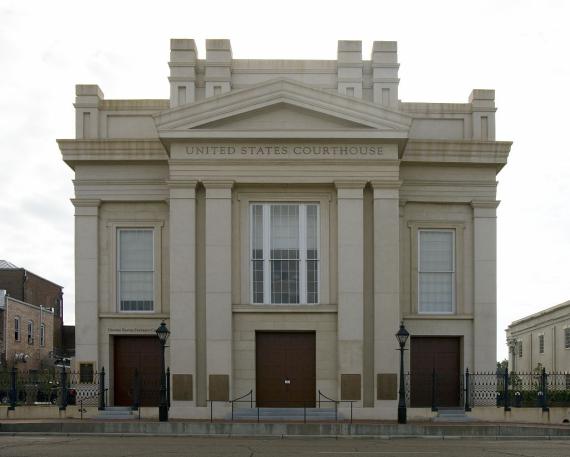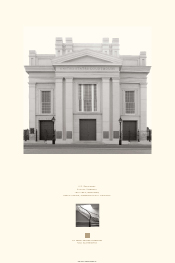Location: 111 S Pearl St, Natchez, MS 39120
History
The U.S. Courthouse, originally known as Institute Hall, opened on Independence Day 1853 as a gathering place for the adjacent Natchez Institute School. The building quickly became the city’s entertainment venue, hosting traveling acts and local celebrations. By the 1890s, newspapers called the building, which briefly doubled as a roller rink, Opera Hall. In 1901 the basement level girl’s classrooms relocated to the newly replaced school and that same year a new concert hall opened, leaving the building virtually empty.
In 1921, the American Legion refashioned the building as a World War I monument, adding a proscenium stage, patriotic decor, bronze plaques and renaming it Memorial Hall. The newly renamed building continued to serve a wide variety of purposes for the city throughout the twentieth century. It was a teen canteen, a library, a charity clothing drop-off center, a museum, an American Legion hall, a place for the city to store voting booths, a location for boxing matches, and it occasionally still hosted public performances. One notable use began in 1932, as the first pageant was held in Memorial Hall during the Natchez Pilgrimage, the nation’s second oldest organized house tour. By the 1970s, however, the building was in a decaying condition. In 1987, the historic Natchez Foundation, working with the city, purchased the dilapidated building, began emergency repairs, and waited for a preservation-supportive occupant.
As the result of a downsized need for U.S. District court space in southern Mississippi, the decision was made to relocate the courts to Natchez. Through a partnership involving federal, state, and local agencies working closely with Waggonner & Ball Architects, Memorial Hall was rehabilitated for use as a U.S. Courthouse. In 2007, as it had over two hundred years earlier as capital of the Mississippi Territory, Natchez once again hosted a federal court. In the 1852 cornerstone laying ceremony for Institute Hall, with words prescient to its recent revitalization, the president of the Natchez Board of Education stated the building would “serve as a monument to the past showing what can be accomplished in a few years by willing hearts and ready hands. It will be a beacon in the future, calling for deeds to emulate the past.” This sentiment endures in the new Natchez U.S. Courthouse.
Architecture
Originally called Institute Hall, the U.S. Courthouse in Natchez is a rare example of a nineteenth-century Greek Revival auditorium. Designed by noted English-born Kentucky architect Thomas Lewinski, while he worked as supervisor of the construction of a nearby Marine Hospital, the Greek Revival style building resembles Lewinski’s work in Kentucky more so than the Greek Revival mansions of Natchez. The courthouse is rectangular in plan with two stories and a gabled roof. A primary Greek Revival feature is its symmetrical, three-bay facade, classically detailed with a centered, single bay engaged portico flanked by recessed side bays. The engaged portico features paired pilasters supporting a triple banded architrave, a wide frieze, a molded cornice, and a pediment. A molded panel parapet surmounts the facade with paired piers that echo the arrangement of the pilasters below them. The wide frieze continues along either side of the building, which is brick clad and has six window bays along its lower levels. The upper levels of the building contain larger wood windows. The second story above the main entrance contains a more elaborate double-height window with multi-light sidelights. The rear elevation has a central portico with pilasters rendered in brick, and it also features a modern stairwell addition enclosed in semi-opaque glass, constructed as part of the building’s recent rehabilitation. The front elevation on Pearl Street includes its original ornamental wrought iron fence and two decorative pole light fixtures, recreated based upon original documentation.
Entranceways are present at each of the facade’s three bays. The main entrance, located in the center bay, is composed of a pair of eight paneled molded doors that open onto a foyer. Inside, a pair of wood doors adorned with upper panel patterning of octagonal openings is present at the foyer’s rear wall. They are set within a wide wood surround with a peaked lintel containing a federal-style eagle motif in the center. The doors lead into a corridor that continues the length of the building with offices located off of either side of it. Within the foyer are symmetrically placed matching staircases that lead to the second floor. Each is comprised of turned wood newels and balusters, makes two quarter turns, and each has winders at beginning and end. The grand staircase leads to a second floor landing at the entrance to the main courtroom.
The second level features a large open space that was originally an auditorium, and was rehabilitated into a federal courtroom. The courtroom space, with blonde wood partitions, is a recently added room within the larger pre-existing space. To give visitors a sense of the original width of the room and allow light to penetrate the courtroom, above eye level, wood louvers and glass panels top the partitions. A turned spindle wood balustrade, for a former balcony at the room’s rear wall, is retained.
History
- 1851-1853: Building designed and constructed to provide public school auditorium and classroom space
- 1890s: Referred to as the Opera Hall, building becomes the city’s entertainment venue
- 1901: Both new school building and new concert hall are constructed, leaving the building almost vacant
- 1921: Renovated by the American Legion and renamed Memorial Hall in honor of World War I veterans
- 1930s: Used as pageant venue for the Natchez Pilgrimage House Tour
- 1965: Natchez library, housed in basement since 1883, relocates
- 1968-1970s: Natchez Museum occupies auditorium
- 1979: Building listed in National Register of Historic Places
- 1986-1987: After auditorium ceiling collapses, Historic Natchez Foundation acquires building and champions its preservation
- 2004: GSA acquires building and begins, in conjunction with many public and private agencies, its rehabilitation into a courthouse
- 2007: U.S. Courthouse in Natchez begins session
Facts
- Architects: Thomas Lewinski; Waggonner & Ball Architects
- Architectural Style: Greek Revival
- Construction Dates: 1851-1853; 2003-2007
- GSA Building Number: MS0008ZZ
- Landmark Status: Listed in the National Register of Historic Places
- Primary Materials: Brick and stucco
- Prominent Features: Classical facade with parapet; Courtroom in original two-story auditorium; Elaborate staircases
Poster Download
Download the poster [PDF - 205 KB]

 U.S. General Services Administration
U.S. General Services Administration

